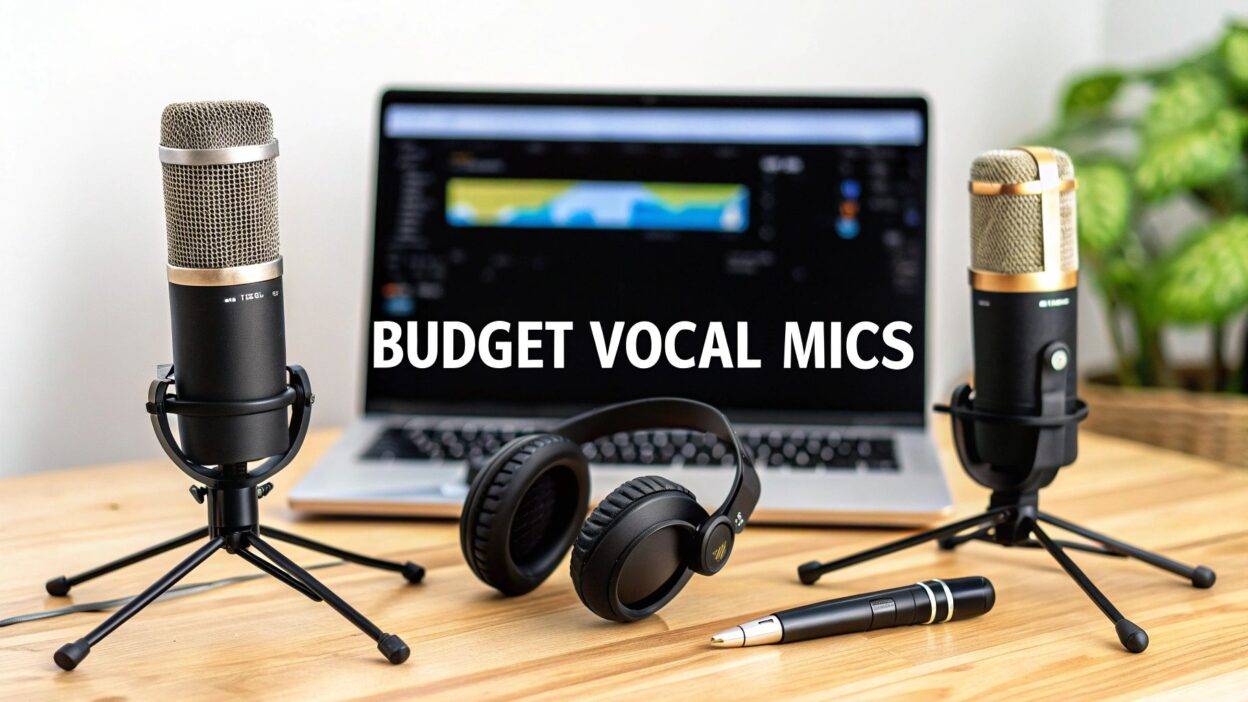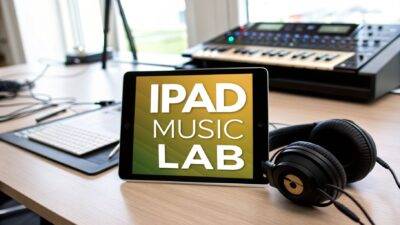Unlocking Pro Vocals on a Budget
Ready to capture studio-quality vocals without breaking the bank? This listicle unveils the best budget microphones for recording vocals, empowering you to elevate your audio productions. We'll equip you with the knowledge to choose the perfect microphone for your unique vocal style and budget. This detailed roundup explores key specifications, weighs pros and cons, compares prices, and provides actionable buying tips.
Finding the right microphone is crucial for capturing nuanced vocals and ensuring professional-sounding recordings. This list specifically targets aspiring music producers, songwriters, independent artists, and anyone seeking to optimize their home studio setup without overspending.
We'll cover six exceptional budget microphones:
- Samson Q2U
- Audio-Technica AT2020
- Shure SM58
- Rode PodMic
- Behringer B-1
- Blue Yeti Nano
From dynamic workhorses ideal for live performance and podcasting to condenser mics perfect for capturing subtle vocal details in studio recordings, this listicle has something for everyone. Learn how each microphone performs, discover their strengths and weaknesses, and find the best budget microphone for recording vocals to transform your audio projects.
1. Samson Q2U
The Samson Q2U is a dynamic microphone celebrated for its hybrid interface, offering both XLR and USB connectivity. This dual functionality makes it incredibly versatile, bridging the gap between traditional analog setups and the convenience of digital recording. For beginners venturing into vocal recording, the plug-and-play USB connection simplifies the process, while intermediate users can leverage the XLR output for enhanced audio quality in more complex setups. This adaptability makes the Q2U a best budget microphone for recording vocals.
Why the Samson Q2U is a Top Choice
The Q2U's popularity stems from its unique blend of affordability and performance. Its dynamic capsule delivers broadcast-quality sound, making it suitable for a wide range of applications, from podcasting and YouTube content creation to vocal overdubs in project studios. The Q2U consistently ranks highly in "best budget microphone for recording vocals" roundups due to its versatility.
Many podcasters and YouTubers rely on the Q2U for its clear and focused sound reproduction, while home studio enthusiasts appreciate its ease of use. It's even a common fixture in broadcasting applications and audio engineering schools.
Optimizing Your Recording with the Samson Q2U
To maximize the Q2U's potential, consider these actionable tips:
- Positioning: Maintain a distance of 2-4 inches from your mouth to capture optimal sound. Experimenting with slight off-axis positioning can help mitigate plosives (bursts of air from certain sounds).
- Connectivity: For the highest audio quality, use the XLR output connected to an audio interface. Learn more about using an audio interface and the Samson Q2U by exploring resources like how to record music at home.
- Filtering: Engage the high-pass filter on your audio interface to reduce low-frequency rumble and background noise.
This video provides a comprehensive overview of the Samson Q2U's features and functionalities.
Samson Q2U: Features, Pros, and Cons at a Glance
The following bar chart visually compares the number of key features, pros, and cons of the Samson Q2U, providing a quick snapshot of its strengths and weaknesses.
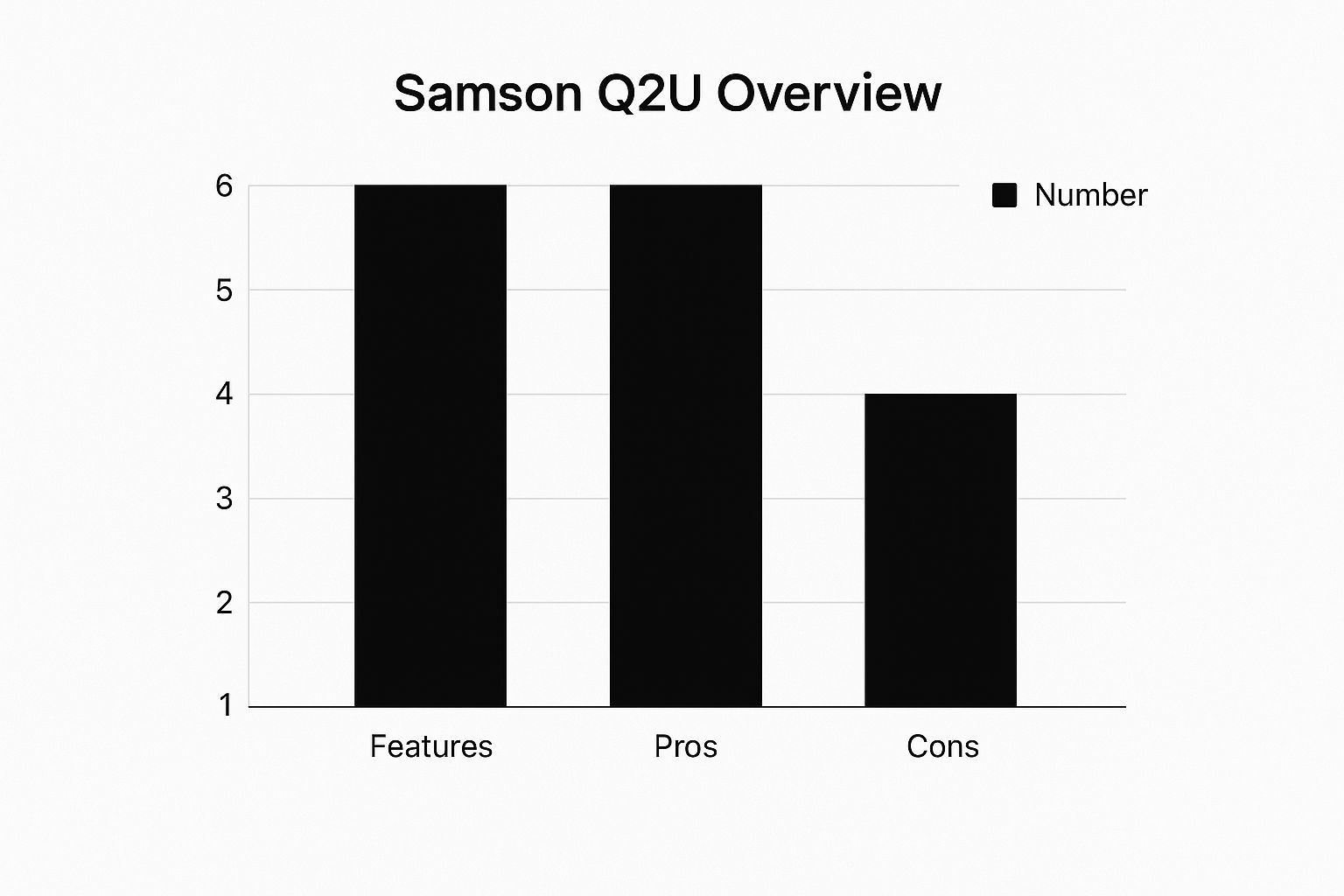
As the infographic illustrates, the Samson Q2U boasts a strong profile with more pros than cons and a good number of valuable features, reinforcing its status as a best budget microphone for recording vocals. The six core features, including dual connectivity and a rugged build, contribute to its versatility. While it has only four minor cons, its six prominent pros, such as excellent sound quality for its price point and ease of use, make it a compelling choice for beginners and experienced users alike.
2. Audio-Technica AT2020
The Audio-Technica AT2020 is a side-address cardioid condenser microphone renowned for its exceptional clarity and detailed sound reproduction. This microphone has become a staple in home and professional studios alike, offering professional build quality at an incredibly affordable price point, making it a top contender for the best budget microphone for recording vocals. Its ability to capture nuances in vocal performances makes it a versatile tool for various recording applications.
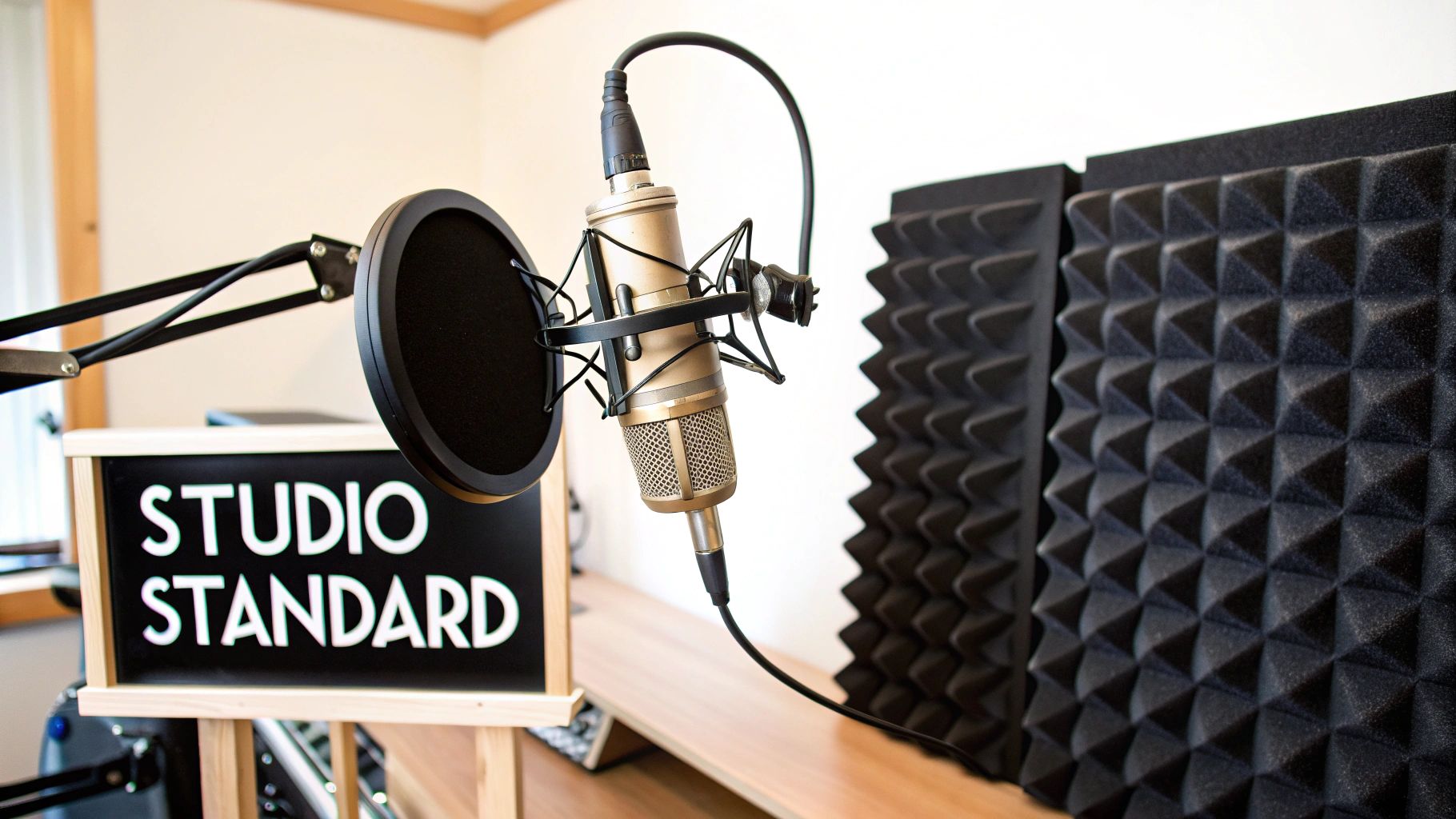
Why the Audio-Technica AT2020 is a Top Choice
The AT2020's widespread popularity stems from its impressive balance of affordability and performance. Its condenser capsule delivers a crisp, detailed sound that rivals microphones costing significantly more. This quality makes it suitable for capturing vocals, acoustic instruments, and even voiceover work. This microphone consistently appears on "best budget microphone for recording vocals" lists.
From aspiring singers and songwriters to podcasters and YouTubers, the AT2020 has become a go-to choice for its clear and accurate sound reproduction. Its presence in professional recording studios and college music programs further underscores its value and performance capabilities.
Optimizing Your Recording with the Audio-Technica AT2020
To get the most out of your AT2020, consider these practical tips:
- Room Acoustics: Since the AT2020 is a condenser microphone, it's sensitive to room reflections. Record in an acoustically treated room or create a makeshift vocal booth to minimize unwanted reverberations.
- Positioning: Place the microphone 6-8 inches from your mouth. Experiment with slight adjustments to find the sweet spot that captures your voice best.
- Accessories: Invest in a quality shock mount to reduce vibrations and a pop filter to minimize plosives (bursts of air from "p" and "b" sounds).
Audio-Technica AT2020: Features, Pros, and Cons at a Glance
The AT2020 stands out for its detailed sound, affordable price, and durable construction, making it a best budget microphone for recording vocals. Key features include its cardioid polar pattern, wide frequency response, and high SPL handling. While it's sensitive to room noise and requires 48V phantom power, its exceptional performance for the price outweighs these minor considerations.
3. Shure SM58
The Shure SM58 is a legendary dynamic microphone, renowned as an industry standard for over 50 years. Primarily designed for live performance, its warm tone and exceptional durability make it a surprisingly excellent choice for recording vocals, especially on a budget. This iconic microphone has graced countless hit records and remains a staple in professional studios worldwide. Its rugged build and consistent performance have solidified its position as a reliable workhorse for vocalists across various genres.
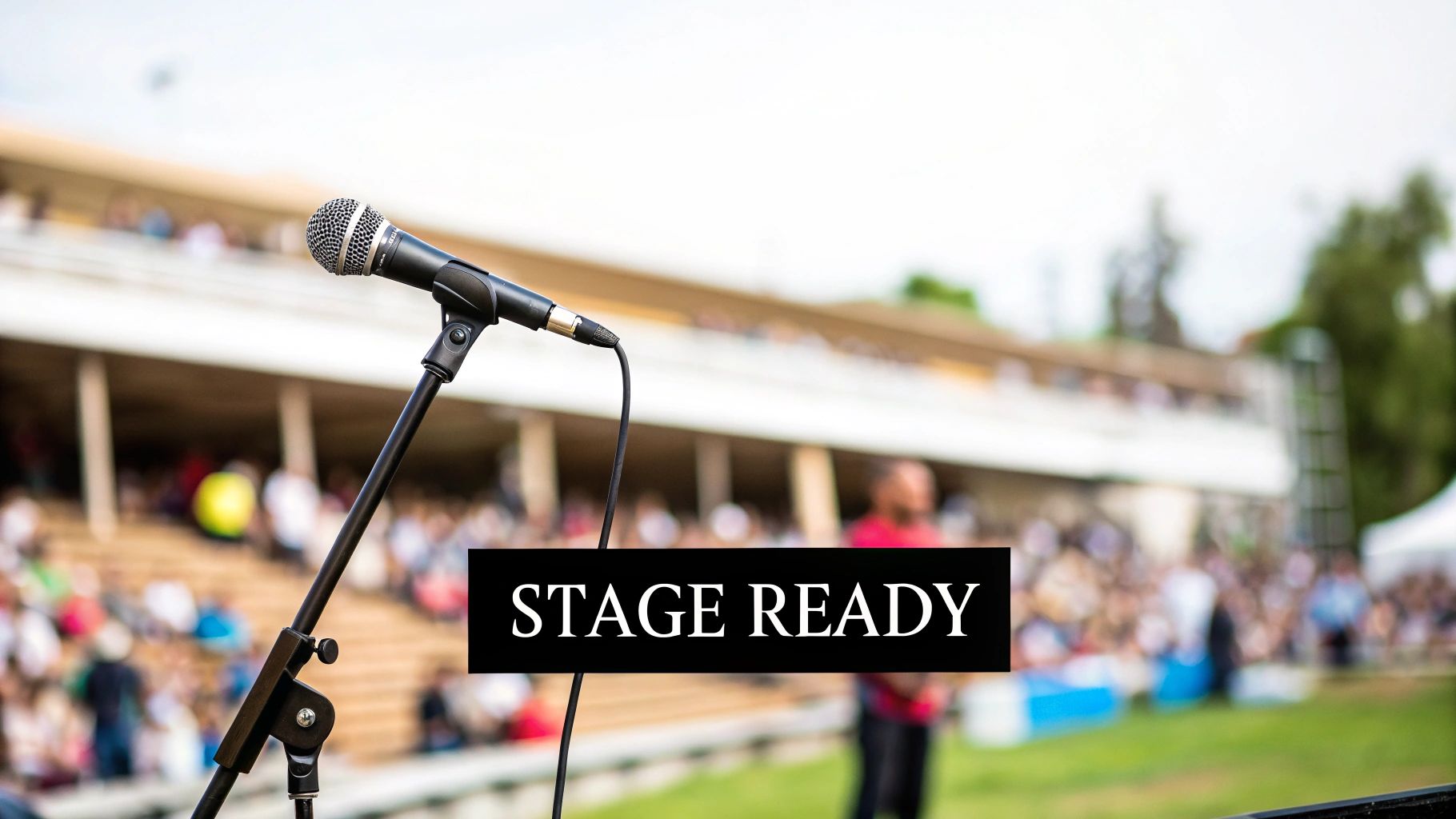
Why the Shure SM58 is a Top Choice
The SM58's enduring popularity stems from its robust construction, clear sound reproduction, and affordability. Its cardioid polar pattern effectively isolates the vocalist's voice, minimizing background noise and unwanted ambience. This focused capture is crucial for achieving clean and professional-sounding vocal recordings, even in less-than-ideal acoustic environments. Its ability to handle high sound pressure levels makes it suitable for capturing powerful vocals without distortion.
Many rock and pop vocalists prefer the SM58 for its warm, slightly compressed sound, which adds a desirable character to their performances. Its versatility extends to both studio and live applications, making it a valuable investment for any aspiring vocalist. Its renowned durability ensures it can withstand the rigors of touring and frequent handling, making it a long-term investment.
Optimizing Your Recording with the Shure SM58
To fully utilize the Shure SM58's potential for recording vocals, consider these practical tips:
- Proximity Effect: Position the microphone very close to your mouth (1-3 inches) to take advantage of the proximity effect. This technique boosts the low frequencies, adding warmth and fullness to your voice.
- Compression and EQ: Employ compression to even out the dynamic range and bring out subtle details in your vocal performance. A slight EQ boost around 5-8kHz can add presence and clarity. If your recording environment isn't ideal, consider how acoustic treatment can improve sound quality; learn more about acoustic treatment for a home studio.
- Layering Vocals: The SM58 excels at capturing double-tracked and harmony vocals. Its consistent sound ensures that layered vocals blend seamlessly, creating a rich and polished vocal sound.
Shure SM58: Features, Pros, and Cons at a Glance
The Shure SM58 offers a compelling combination of performance and affordability, making it a best budget microphone for recording vocals. Its rugged build, consistent sound, and versatility have earned it a place in recording studios worldwide. While its primary design caters to live performance, its ability to capture warm and impactful vocals translates exceptionally well to studio recordings.
4. Rode PodMic
The Rode PodMic is a dynamic microphone explicitly engineered for podcasting and vocal recording. It’s known for its rich, warm sound signature and superb background noise rejection, making it a best budget microphone for recording vocals, especially in less-than-ideal acoustic environments. This focused design makes it particularly attractive for home studio setups where complete sound isolation might not be feasible.
Why the Rode PodMic is a Top Choice
The PodMic distinguishes itself through its broadcast-quality sound at an accessible price point. Its tight cardioid polar pattern effectively minimizes unwanted background noise, focusing solely on the sound source directly in front of it. This characteristic is invaluable for podcasters, voiceover artists, and vocalists working in untreated rooms.
This microphone is a favorite among podcasters, YouTubers creating voice-heavy content, and even musicians looking for a distinctive character in their vocal recordings. Its robust build quality further enhances its appeal, ensuring durability for long-term use.
Optimizing Your Recording with the Rode PodMic
Unlock the full potential of your Rode PodMic by implementing these practical tips:
- Positioning: Maintain a distance of 2-4 inches from the microphone. Experiment with subtle off-axis angles to further minimize plosives.
- Boom Arm Usage: Employing a boom arm facilitates optimal microphone placement and reduces handling noise. This allows for greater flexibility and control during recording sessions.
- Preamp Pairing: Connect the PodMic to a high-gain, clean preamp to fully realize its rich sound. Consider using a dedicated XLR audio interface to achieve professional-level results.
- Compression: Apply gentle compression to maintain consistent vocal levels throughout your recordings. This creates a more polished and professional sound.
Rode PodMic: Features, Pros, and Cons at a Glance
The Rode PodMic offers a distinctive value proposition with its targeted design and performance capabilities. Its specialized features cater specifically to voice recording needs, while its robust build and focused sound capture represent clear strengths. Though there are some minor limitations, the strengths of the PodMic make it an excellent choice for those seeking professional-grade results on a budget.
5. Behringer B-1
The Behringer B-1 is a large-diaphragm condenser microphone renowned for offering professional features at an incredibly accessible price. This makes it a strong contender for the best budget microphone for recording vocals, especially for those just starting out. Despite its low cost, the B-1 delivers surprisingly good performance for home studio vocal recording, capturing nuanced details and providing a respectable frequency response. This affordability opens doors for aspiring musicians to experiment with high-quality recording without breaking the bank.
Why the Behringer B-1 is a Top Choice
The B-1's appeal lies in its remarkable value proposition. It provides a taste of professional-grade condenser microphone performance at a fraction of the cost of its higher-end counterparts. This makes it an excellent entry point for beginners eager to explore the world of vocal recording. The large-diaphragm design contributes to a warm, rich sound often favored for vocals, making it a compelling choice for those seeking a best budget microphone for recording vocals.
Its popularity is evident in its widespread use among beginning home recordists, budget project studios, and music students. The B-1 is frequently employed for demo recordings, allowing artists to capture their ideas with decent fidelity before investing in more expensive equipment. It's a testament to its capability that even experienced professionals sometimes utilize the B-1 as a secondary microphone or for specific recording tasks.
Optimizing Your Recording with the Behringer B-1
To get the most out of your Behringer B-1, consider these practical tips:
- Filtering: Utilize the built-in low-cut filter to minimize low-frequency rumble and unwanted background noise. This is particularly helpful in less-than-ideal recording environments.
- De-essing: Apply gentle de-essing in your mixing software to tame any harshness in the high frequencies, especially with sibilant sounds. This can significantly improve the overall smoothness of your vocal recordings.
- Acoustic Treatment: Ensure your recording space has adequate acoustic treatment to minimize reflections and reverberations. Even simple measures like using blankets or foam panels can make a noticeable difference.
- Upgrading: While the B-1 is a great starting point, consider upgrading to a higher-end microphone as you gain experience and your budget allows. This will further elevate the quality of your recordings.
Behringer B-1: Features, Pros, and Cons at a Glance
The Behringer B-1, while a budget-friendly option, offers a compelling combination of features and performance. Its pros significantly outweigh its cons, making it a solid choice for the best budget microphone for recording vocals. The included shock mount helps isolate the microphone from vibrations, and the cardioid polar pattern effectively rejects unwanted sounds from the sides and rear. While it may not compete with high-end microphones in terms of absolute detail and clarity, it offers exceptional value for its price, enabling aspiring vocalists to achieve professional-sounding recordings without a hefty investment.
6. Blue Yeti Nano
The Blue Yeti Nano is a compact USB condenser microphone perfect for content creators and home recording enthusiasts. Its plug-and-play design simplifies setup, making it exceptionally user-friendly, especially for beginners. Don't let its small size fool you; this microphone delivers surprisingly robust vocal recording quality, punching well above its weight in terms of performance and making it a solid contender for the best budget microphone for recording vocals.
Why the Blue Yeti Nano is a Top Choice
The Blue Yeti Nano earns its spot on this list due to its impressive combination of portability, affordability, and sound quality. Its two pickup patterns – cardioid and omnidirectional – offer flexibility for various recording scenarios. Cardioid mode focuses on sound directly in front of the microphone, ideal for capturing vocals, while omnidirectional mode picks up sound from all directions, suitable for conference calls or group recordings. This versatility, combined with its compact design, makes it a popular choice for podcasters, YouTubers, and streamers.
Many individuals use the Blue Yeti Nano for recording vocals in home studios, creating voiceovers, and participating in online meetings. Its ease of use makes it particularly attractive to those new to recording, while its respectable sound quality ensures recordings sound professional and polished. Its small footprint also makes it ideal for limited desktop space.
Optimizing Your Recording with the Blue Yeti Nano
To get the most out of your Blue Yeti Nano, consider these tips:
- Positioning: For vocal recordings, use cardioid mode and position the microphone 6-12 inches from your mouth. Experiment to find the sweet spot that captures your voice best.
- Mounting: Use a boom arm to isolate the microphone from desk vibrations and improve positioning flexibility. If a dedicated audio interface is in your plans, learn more about how to integrate it into your setup and explore the best audio interface for beginners using this helpful resource: Learn more about….
- Acoustic Treatment: Record in a space with minimal background noise and reflections. Even simple measures like hanging blankets or using acoustic panels can significantly improve sound quality.
- Pop Filter: Use a pop filter to minimize plosives (bursts of air from "p" and "b" sounds) and protect the microphone capsule.
Blue Yeti Nano: Features, Pros, and Cons at a Glance
The Blue Yeti Nano is a well-rounded microphone, offering a streamlined experience focused on core functionality. Its two pickup patterns, user-friendly interface, and compact design are notable features that make it a convenient and practical choice for recording high-quality audio. Its few cons are easily manageable with the proper techniques and readily available accessories. While not offering a vast array of features, its strong value proposition reinforces its position as a best budget microphone for recording vocals, providing essential functionalities in a convenient and compact package.
Budget Microphone Comparison for Vocal Recording
| Microphone | 🔄 Implementation Complexity | 💡 Ideal Use Cases | ⚡ Resource Requirements | 📊 Expected Outcomes | ⭐ Key Advantages |
|---|---|---|---|---|---|
| Samson Q2U | Moderate – USB plug-and-play or XLR requires interface | Podcasting, home studio vocals, broadcasting | USB connection needs minimal gear; XLR needs interface | Good broadcast-quality sound; versatile | Dual connectivity; noise rejection; durable |
| Audio-Technica AT2020 | Higher – XLR only, needs phantom power and interface | Studio vocal, voiceover in treated rooms | Requires quality audio interface and phantom power | Clear, detailed recordings with low noise | Excellent clarity; high SPL handling |
| Shure SM58 | Moderate – XLR only, no phantom power required | Live vocals, studio vocals, robust environments | Interface needed but no phantom power | Warm, reliable vocal sound; high durability | Legendary durability; feedback rejection |
| Rode PodMic | Moderate – XLR only, no phantom power but interface required | Podcasting, voiceover, untreated rooms | Needs audio interface, gain boost often needed | Warm, rich sound optimized for speech | Built-in pop filter; great noise rejection |
| Behringer B-1 | Higher – XLR only, phantom power required | Budget home studio, demo recordings | Requires interface with phantom power | Decent sound with some noise and harshness | Very affordable; accessories included |
| Blue Yeti Nano | Low – USB only, plug-and-play | Streaming, podcasting, home office calls | No interface required | Good USB sound with monitoring | Easy setup; built-in headphone monitoring |
Fine-Tuning Your Vocal Sound
Finding the best budget microphone for recording vocals involves carefully balancing audio quality, features, and affordability. From the dynamic workhorse Shure SM58 to the versatile Samson Q2U, we've explored six excellent options, each offering a unique blend of strengths for various recording needs. Remember, the "best" microphone truly depends on your specific vocal style, recording environment, and budget.
Beyond the Microphone: Elevating Your Recordings
Selecting a microphone is merely the first step towards achieving professional-sounding vocals. Consider these crucial factors to further refine your recordings:
-
Acoustic Treatment: Even the best budget microphone for recording vocals will pick up unwanted room reflections and background noise. Treating your recording space with acoustic panels, bass traps, or even strategically placed blankets and furniture can drastically improve the clarity and focus of your vocal recordings.
-
Microphone Technique: Proper microphone placement and technique are paramount. Experiment with different distances and angles to find the sweet spot for your voice and microphone. A pop filter can also help mitigate plosives (harsh sounds from "p" and "b" consonants).
-
Audio Interface: A quality audio interface acts as the bridge between your microphone and computer, ensuring a clean and accurate signal. While some microphones offer USB connectivity for direct recording, a dedicated audio interface often provides superior sound quality and more control over your input levels.
Maximizing Your Microphone's Potential
With thoughtful consideration of these elements, you can elevate your vocal recordings regardless of your microphone's price point. This reinforces the idea that even budget-friendly options, like the Behringer B-1 or Blue Yeti Nano, can deliver impressive results with the right approach.
-
Gain Staging: Proper gain staging ensures a strong, clean signal without clipping (distortion). Start with low gain on both your interface and recording software, gradually increasing until the signal is strong but not peaking.
-
EQ and Compression: Use equalization (EQ) to sculpt your vocal tone, boosting desired frequencies and cutting unwanted ones. Compression helps to even out the dynamics of your performance, making quieter parts louder and louder parts softer.
-
Experimentation: Don't be afraid to experiment with different microphone placements, settings, and processing techniques. Every voice and microphone is unique, so finding what works best for you requires exploration.
By mastering these concepts, you’ll unlock the full potential of your chosen microphone and create vocal recordings that truly shine. Remember, capturing a captivating vocal performance isn't solely about expensive equipment; it's about understanding the interplay of these elements and applying them effectively.
Unlock your full vocal potential by exploring resources on acoustic treatment, microphone technique, and audio interface selection at ChordX. ChordX offers personalized guidance and tools, including AI-powered assistance, specifically designed to enhance your recordings and streamline your workflow, regardless of which best budget microphone for recording vocals you choose.
